
A stamp mill (or stamp battery or stamping mill) is a type of mill machine that crushes material by pounding rather than grinding, either for further processing or for extraction of metallic ores. Breaking material down is a type of unit operation.

A stamp mill (or stamp battery or stamping mill) is a type of mill machine that crushes material by pounding rather than grinding, either for further processing or for extraction of metallic ores. Breaking material down is a type of unit operation.


A stamp mill consists of a set of heavy steel (iron-shod wood in some cases) stamps, loosely held vertically in a frame, in which the stamps can slide up and down. They are lifted by cams on a horizontal rotating shaft. As the cam moves from under the stamp, the stamp falls onto the ore below, crushing the rock, and the lifting process is repeated at the next pass of the cam.
Each one frame and stamp set is sometimes called a "battery" or, confusingly, a "stamp" and mills are sometimes categorised by how many stamps they have, i.e. a "10 stamp mill" has 10 sets. They usually are arranged linearly, but when a mill is enlarged, a new line of them may be constructed rather than extending the line. Abandoned mill sites (as documented by industrial archaeologists) will usually have linear rows of foundation sets as their most prominent visible feature as the overall apparatus can exceed 20 feet in height, requiring large foundations. Stamps are usually arranged in sets of five.
Some ore processing applications used large quantities of water so some stamp mills are located near natural or artificial bodies of water. For example, the Redridge Steel Dam was built to supply stamp mills with process water. The California Stamp made its major debut at the 1894 San Francisco midsummer fair. It was the first type that generated electricity, powered by a wood feed steam boiler. Steam started the wheels and belts turning; a generator that also was steam driven supplied the electricity for overhead lighting. This was a big plus for a mining company, enabling more production time.

The main components for water-powered stamp mills – water wheels, cams, and hammers – were known in the Hellenistic era in the Eastern Mediterranean region. [1] Ancient cams are in evidence in early water-powered automata from the third century BC. [2] A passage in the Natural History of the Roman scholar Pliny (NH 18.23) indicates that water-driven pestles had become fairly widespread in Italy by the first century AD: "The greater part of Italy uses an unshod pestle and also wheels which water turns as it flows past, and a trip-hammer [mola]". [2] These trip-hammers were used for the pounding and hulling of grain. [2] Grain-pounders with pestles, as well as ordinary watermills, are also attested as late as the middle of the fifth century in a monastery founded by Romanus of Condat in the remote Jura region, indicating that the knowledge of trip hammers continued into the early Middle Ages. [2] Apart from agricultural processing, archaeological evidence also strongly suggests the existence of trip hammers in Roman metal working. In Ickham in Kent, a large metal hammer-head with mechanical deformations was excavated in an area where several Roman water-mills and metal waste dumps have also been traced. [2]
The widest application of stamp mills, however, seems to have occurred in Roman mining, where ore from deep veins was first crushed into small pieces for further processing. [3] Here, the regularity and spacing of large indentations on stone anvils indicate the use of cam-operated ore stamps, much like the devices of later medieval mining. [3] [4] Such mechanically deformed anvils have been found at numerous Roman silver and gold mining sites in Western Europe, including at Dolaucothi (Wales), and on the Iberian Peninsula, [3] [4] [5] where the datable examples are from the 1st and 2nd century AD. [6] At Dolaucothi, these stamp mills were hydraulic-driven and possibly also at other Roman mining sites, where the large scale use of the hushing and ground sluicing technique meant that large amounts of water were directly available for powering the machines. [3] [7]
Stamp mills were used by miners in Samarkand as early as 973. They were used in medieval Persia to crush mineral ores. By the 11th century, stamp mills were in widespread use throughout the medieval Islamic world, from Islamic Spain and North Africa in the west to Central Asia in the east. [8]
Water-powered and mechanised trip hammers reappeared in medieval Europe by the 12th century. Their use was described in medieval written sources of Styria (in modern-day Austria), one from 1135, and another from 1175. Both texts mentioned the use of vertical stamp mills for ore-crushing. Medieval French sources of the years 1116 and 1249 both record the use of mechanised trip hammers used in the forging of wrought iron. [9] Medieval European trip hammers by the 15th century were most often in the shape of the vertical pestle stamp-mill. [10] The well-known Renaissance artist and inventor Leonardo da Vinci often sketched trip hammers for use in forges and even file-cutting machinery, those of the vertical pestle stamp-mill type. The oldest depicted European illustration of a martinet forge-hammer is perhaps in the Historia de Gentibus Septentrionalibus of Olaus Magnus, dated to 1565 AD. This woodcut image depicts three martinets, and a waterwheel working the wood and leather bellows of an osmund (sv) bloomery furnace. The recumbent trip hammer was first depicted in European artwork in an illustration by Sandrart and Zonca (dated 1621 AD). [11]
Water-powered stamp mills are illustrated in book 8 of Georg Agricola's De Re Metallica , published in 1556. [12] The mills Agricola shows were largely wooden construction, excepting the use of iron shoes on the end of each stamp. The camshaft was set directly on the axle of the waterwheel, and stamps were typically arranged in gangs of three, with each wheel driving one or two gangs.
The first stamp mill in the U.S. was built in 1829 at the Capps mine near Charlotte, North Carolina. [13] They were common in gold, silver, and copper mining regions of the US in the latter 19th and early 20th centuries, in operations where the ore was crushed as a prelude to extracting the metals. They were superseded in the second half of the 19th century in many applications by more efficient methods. However their simplicity meant that they were used in remote areas for ore processing well into the 20th century. (19th century advertisements for some mills highlighted that they could be broken down, packed in by mule in pieces, and assembled on site with only simple tools.) Stamp mills are still in use in Colombia by artisanal miners, powered by electric motors.


Cornish stamps are stamp mills that were developed in Cornwall for use in tin mining in around 1850. Cornish stamps were used to crush small lumps of ore into sand-like material. The stamp was constructed from heavy timber with an iron "head" at the bottom. It was lifted by cams on a rotating axle, and fell on the ore and water mixture, fed into a box beneath. The head normally weighed between 4 and 8 cwt (about 200 to 400 kg) each, and were usually arranged in sets of four, in timber frames. Small stamps were commonly powered by water wheels and larger ones by steam engines.
Californian stamps were based on Cornish stamps and were used for the Californian gold mines. In these stamps the cam is arranged to lift the stamp from the side, so that it causes the stamp to rotate. This evens the wear on the shoe at the foot of the stamp. They were more rapid in action and a single head could crush 1.5 tons of ore as opposed to the Cornish stamps which could only crush 1 ton.[ clarification needed ]

Stamp mills were used in early paper making for preparing the paper-stuff (pulp), before the invention of the Hollander beater, and might have derived from those used in fulling wool. [14] They were used in oil-seed processing prior to pressing the oil from the milled seeds. Early mills were water-powered but mills can also be steam or electric powered.
A stamping mill may refer to a factory that performs stamping.
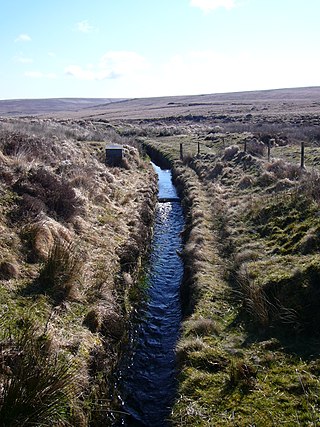
A leat is the name, common in the south and west of England and in Wales, for an artificial watercourse or aqueduct dug into the ground, especially one supplying water to a watermill or its mill pond. Other common uses for leats include delivery of water for hydraulic mining and mineral concentration, for irrigation, to serve a dye works or other industrial plant, and provision of drinking water to a farm or household or as a catchment cut-off to improve the yield of a reservoir.

A watermill or water mill is a mill that uses hydropower. It is a structure that uses a water wheel or water turbine to drive a mechanical process such as milling (grinding), rolling, or hammering. Such processes are needed in the production of many material goods, including flour, lumber, paper, textiles, and many metal products. These watermills may comprise gristmills, sawmills, paper mills, textile mills, hammermills, trip hammering mills, rolling mills, and wire drawing mills.

A water wheel is a machine for converting the kinetic energy of flowing or falling water into useful forms of power, often in a watermill. A water wheel consists of a large wheel, with numerous blades or buckets attached to the outer rim forming the drive mechanism. Water wheels were still in commercial use well into the 20th century, although they are no longer in common use today. Water wheels are used for milling flour in gristmills, grinding wood into pulp for papermaking, hammering wrought iron, machining, ore crushing and pounding fibre for use in the manufacture of cloth.

Mechanization is the process of changing from working largely or exclusively by hand or with animals to doing that work with machinery. In an early engineering text, a machine is defined as follows:
Every machine is constructed for the purpose of performing certain mechanical operations, each of which supposes the existence of two other things besides the machine in question, namely, a moving power, and an object subject to the operation, which may be termed the work to be done. Machines, in fact, are interposed between the power and the work, for the purpose of adapting the one to the other.
A crusher is a machine designed to reduce large rocks into smaller rocks, gravel, sand or rock dust.

The tin mining industry on Dartmoor, Devon, England, is thought to have originated in pre-Roman times, and continued right through to the 20th century, when the last commercially worked mine closed in November 1930, and "composite mines" such as those producing tin as a by- product, such as Hemerdon Mine in Plympton continue to operate today. From the 12th century onwards tin mining was regulated by a stannary parliament which had its own laws.
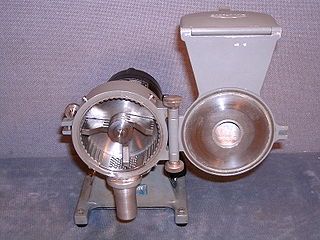
A mill is a device, often a structure, machine or kitchen appliance, that breaks solid materials into smaller pieces by grinding, crushing, or cutting. Such comminution is an important unit operation in many processes. There are many different types of mills and many types of materials processed in them. Historically, mills were powered by hand or by animals, working animal, wind (windmill) or water (watermill). In the modern era, they are usually powered by electricity.

A trip hammer, also known as a tilt hammer or helve hammer, is a massive powered hammer. Traditional uses of trip hammers include pounding, decorticating and polishing of grain in agriculture. In mining, trip hammers were used for crushing metal ores into small pieces, although a stamp mill was more usual for this. In finery forges they were used for drawing out blooms made from wrought iron into more workable bar iron. They were also used for fabricating various articles of wrought iron, latten, steel and other metals.

Mineral processing is the process of separating commercially valuable minerals from their ores in the field of extractive metallurgy. Depending on the processes used in each instance, it is often referred to as ore dressing or ore milling.
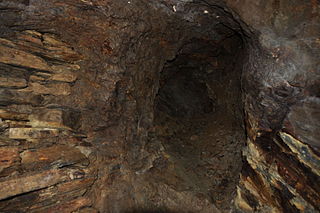
The Dolaucothi Gold Mines, also known as the Ogofau Gold Mine, are ancient Roman surface and underground mines located in the valley of the River Cothi, near Pumsaint, Carmarthenshire, Wales. The gold mines are located within the Dolaucothi Estate, which is owned by the National Trust.
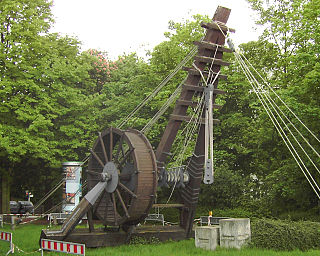
The ancient Romans were famous for their advanced engineering accomplishments. Technology for bringing running water into cities was developed in the east, but transformed by the Romans into a technology inconceivable in Greece. The architecture used in Rome was strongly influenced by Greek and Etruscan sources.

A hammer mill, hammer forge or hammer works was a workshop in the pre-industrial era that was typically used to manufacture semi-finished, wrought iron products or, sometimes, finished agricultural or mining tools, or military weapons. The feature that gave its name to these workshops was the water-driven trip hammer, or set of hammers, used in the process. The shaft, or 'helve', of the hammer was pivoted in the middle and the hammer head was lifted by the action of cams set on a rotating camshaft that periodically depressed the end of the shaft. As it rose and fell, the head of the hammer described an arc. The face of the hammer was made of iron for durability.

De re metallica is a book in Latin cataloguing the state of the art of mining, refining, and smelting metals, published a year posthumously in 1556 due to a delay in preparing woodcuts for the text. The author was Georg Bauer, whose pen name was the Latinized Georgius Agricola. The book remained the authoritative text on mining for 180 years after its publication. It was also an important chemistry text for the period and is significant in the history of chemistry.

Stamp sand is a coarse sand left over from the processing of ore in a stamp mill. In the United States, the most well-known deposits of stamp sand are in the Copper Country of the Upper Peninsula of Michigan, where it is black or dark gray, and may contain hazardous concentrations of trace metals.
The technology history of the Roman military covers the development of and application of technologies for use in the armies and navies of Rome from the Roman Republic to the fall of the Western Roman Empire. The rise of Hellenism and the Roman Republic are generally seen as signalling the end of the Iron Age in the Mediterranean. Roman iron-working was enhanced by a process known as carburization. The Romans used the better properties in their armaments, and the 1,300 years of Roman military technology saw radical changes. The Roman armies of the early empire were much better equipped than early republican armies. Metals used for arms and armor primarily included iron, bronze, and brass. For construction, the army used wood, earth, and stone. The later use of concrete in architecture was widely mirrored in Roman military technology, especially in the application of a military workforce to civilian construction projects.

Mining was one of the most prosperous activities in Roman Britain. Britain was rich in resources such as copper, gold, iron, lead, salt, silver, and tin, materials in high demand in the Roman Empire. Sufficient supply of metals was needed to fulfil the demand for coinage and luxury artefacts by the elite. The Romans started panning and puddling for gold. The abundance of mineral resources in the British Isles was probably one of the reasons for the Roman conquest of Britain. They were able to use advanced technology to find, develop and extract valuable minerals on a scale unequaled until the Middle Ages.

The following outline is provided as an overview of and topical guide to mining:
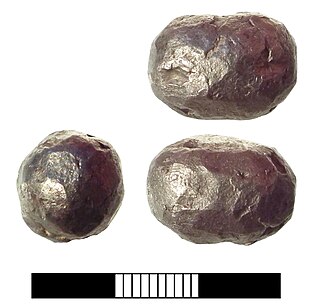
Metals and metal working had been known to the people of modern Italy since the Bronze Age. By 53 BC, Rome had expanded to control an immense expanse of the Mediterranean. This included Italy and its islands, Spain, Macedonia, Africa, Asia Minor, Syria and Greece; by the end of the Emperor Trajan's reign, the Roman Empire had grown further to encompass parts of Britain, Egypt, all of modern Germany west of the Rhine, Dacia, Noricum, Judea, Armenia, Illyria, and Thrace. As the empire grew, so did its need for metals.

Mining in the Upper Harz region of central Germany was a major industry for several centuries, especially for the production of silver, lead, copper, and, latterly, zinc as well. Great wealth was accumulated from the mining of silver from the 16th to the 19th centuries, as well as from important technical inventions. The centre of the mining industry was the group of seven Upper Harz mining towns of Clausthal, Zellerfeld, Sankt Andreasberg, Wildemann, Grund, Lautenthal und Altenau.
The Tiangong Kaiwu (天工開物), or The Exploitation of the Works of Nature was a Chinese encyclopedia compiled by Song Yingxing. It was published in May 1637 with funding provided by Song's patron Tu Shaokui. The Tiangong Kaiwu is an encyclopedia covering a wide range of technical issues, including the use of various gunpowder weapons. Copies of the book were very scarce in China during the Qing dynasty (1644–1911), but original copies of the book were preserved in Japan.
